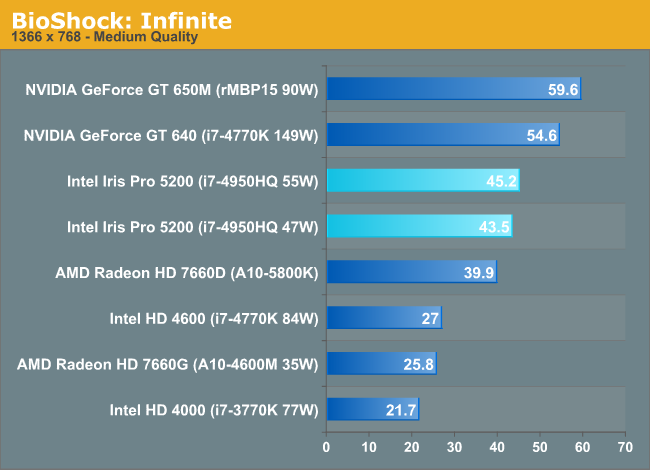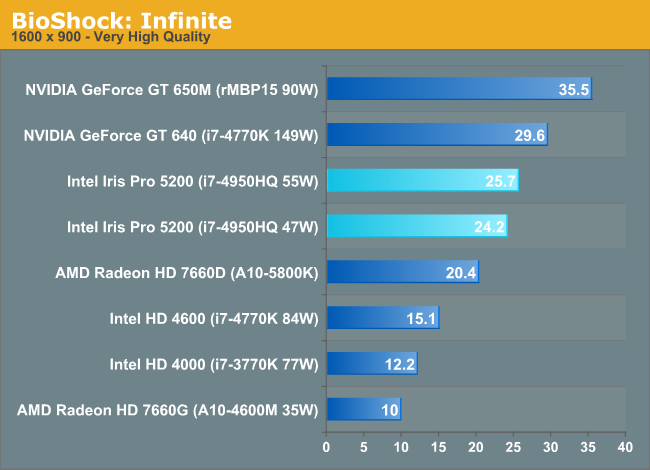Intel Iris Pro 5200 Graphics Review: Core i7-4950HQ Tested
by Anand Lal Shimpi on June 1, 2013 10:01 AM ESTBioShock: Infinite
Bioshock Infinite is Irrational Games’ latest entry in the Bioshock franchise. Though it’s based on Unreal Engine 3 – making it our obligatory UE3 game – Irrational had added a number of effects that make the game rather GPU-intensive on its highest settings. As an added bonus it includes a built-in benchmark composed of several scenes, a rarity for UE3 engine games, so we can easily get a good representation of what Bioshock’s performance is like.

Both the 650M and desktop GT 640 are able to outperform Iris Pro here. Compared to the 55W configuration, the 650M is 32% faster. There's not a huge difference in performance between the GT 640 and 650M, indicating that the performance advantage here isn't due to memory bandwidth but something fundamental to the GPU architecture.
In the grand scheme of things, Iris Pro does extremely well. There isn't an integrated GPU that can touch it. Only the 100W desktop Trinity approaches Iris Pro performance but at more than 2x the TDP.

The standings don't really change at the higher resolution/quality settings, but we do see some of the benefits of Crystalwell appear. A 9% advantage over the 100W desktop Trinity part grows to 18% as memory bandwidth demands increase. Compared to the desktop HD 4000 we're seeing more than 2x the performance, which means in mobile that number will likely grow even further. The mobile Trinity comparison is a shut out as well.










177 Comments
View All Comments
whyso - Saturday, June 1, 2013 - link
They are completely different systems making power consumption values irrelevant.codedivine - Saturday, June 1, 2013 - link
Hi folks. Can you post the OpenCL extensions supported? You can use something like "GPU Caps viewer" from Geeks3d.tipoo - Saturday, June 1, 2013 - link
Interesting that the compute is punches above it's game performance weight. I wonder if they could put more EUs in a chip, maybe a larger eDRAM, and put it on a board as a compute card.lmcd - Saturday, June 1, 2013 - link
They already have a compute card called Xeon Phi if I remember correctly.Klimax - Sunday, June 2, 2013 - link
Different Arch (X86 in Phi)tipoo - Sunday, June 2, 2013 - link
I'm aware, but the Xeon Phi requires completely different programming than a GPU like this which can just use OpenCL.Soul_Master - Saturday, June 1, 2013 - link
What's your point for comparing desktop GPU with middle-range mobile GPU? CPU on both devices are not equal.Soul_Master - Saturday, June 1, 2013 - link
Sorry. I misunderstood about i7 4950HQ process, a high-end quad-core processor for laptops.Ryan Smith - Sunday, June 2, 2013 - link
It's what we had available. We wanted to test a DDR3 version of GK107, and that's what was on-hand.tipoo - Saturday, June 1, 2013 - link
Hmm, so it's heavily hinted at that the next rMBP will ditch discreet graphics. The 5200 is good, but that would still be a regression in performance. Not the first time Apple would have done that, there was the Radeon cut out of the Mini, the 320M to the 3000, even the bottom rung of the newest iMac with the 640m. I wonder if it would at least be cheaper to make up for it.